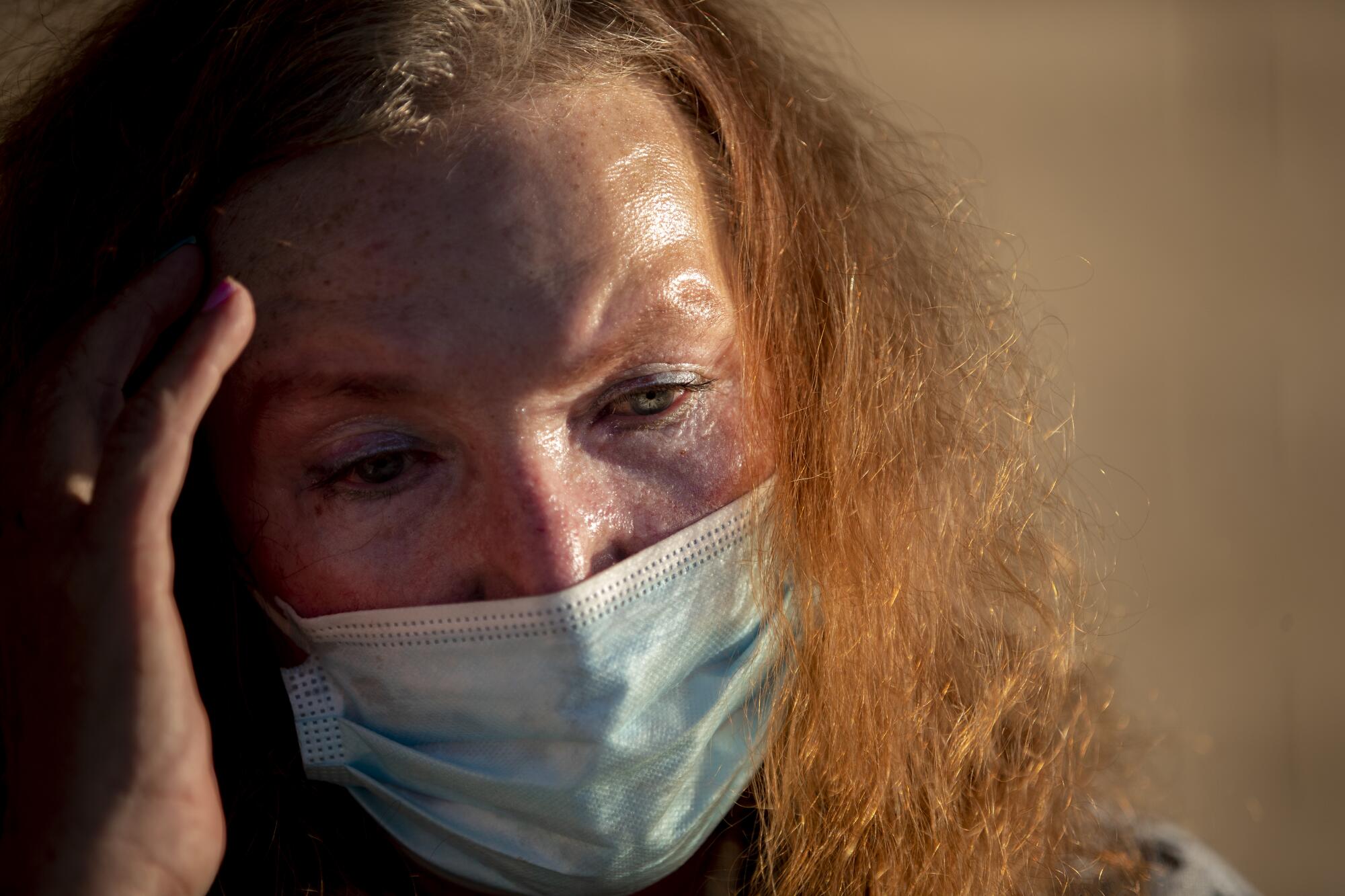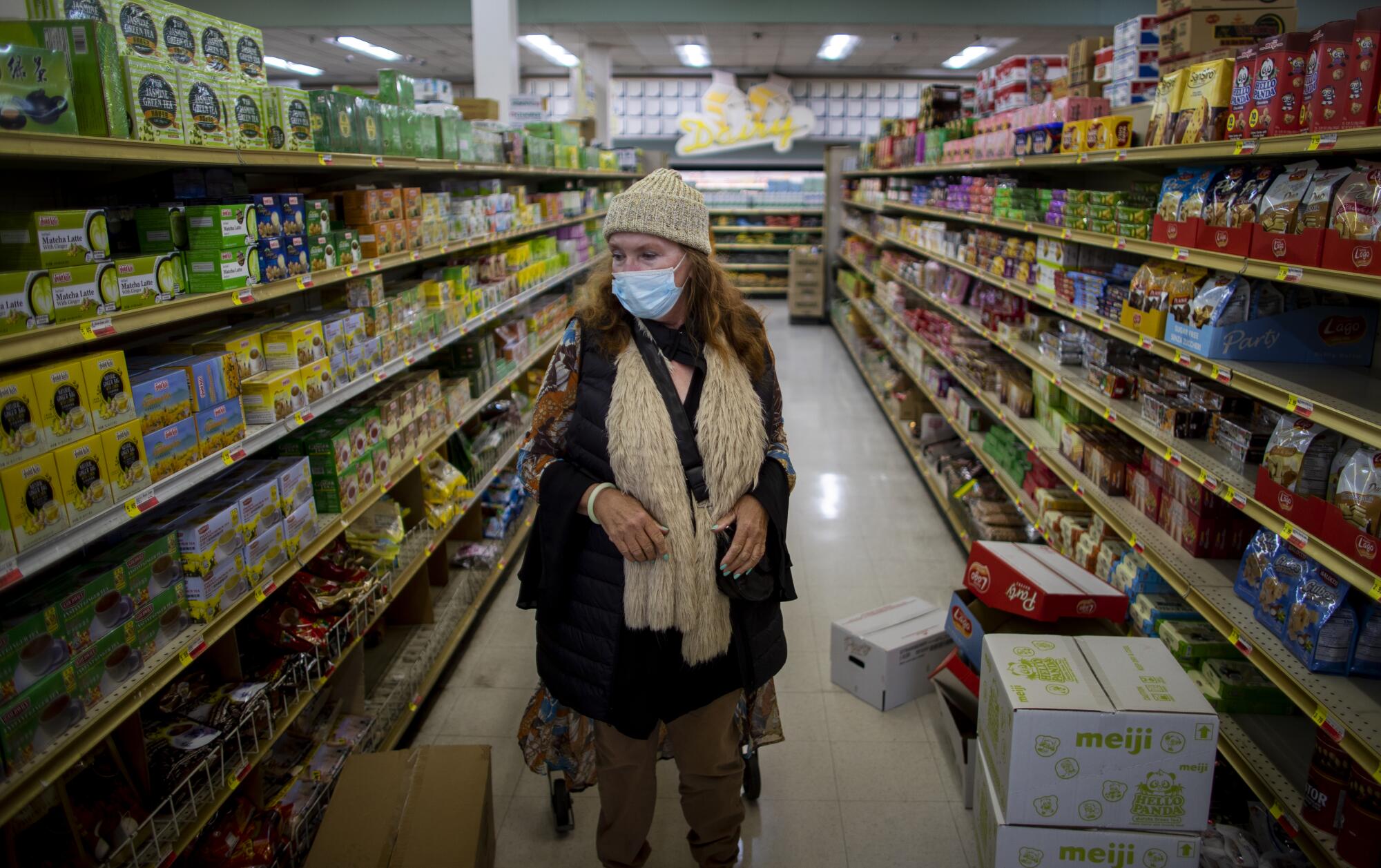
- Share via
One night in February 2020, police officers asked Nancy Wood to leave the park in Fountain Valley where she slept.
Over the next year, they came again and again, shining a spotlight into her tent and calling her by name through a megaphone.
They put her in handcuffs and arrested her, seizing her belongings. She racked up seven citations in the months that followed. And she kept pitching her tent.
In a Westminster courtroom earlier this month, Wood told jurors why she has insisted on claiming a small patch of Mile Square Regional Park.
At 75, she has heart problems. Homeless shelters have restrictive hours and are too far from her doctor.
During the COVID-19 pandemic, she is afraid to sleep indoors near strangers.
“You don’t know who is there, and you don’t know what’s going to happen next,” she said. “At the park, I know what to expect.”
Homeless people rarely fight minor criminal charges all the way to trial. It’s easier to settle the case and bed down in a less visible spot.

Wood’s battle is a product of her natural stubbornness and her craving for safety and privacy, as well as the comfort she finds in park regulars who talk with her and sometimes bring her food and gifts. One person offered a portable power supply, worth nearly a thousand dollars, for Christmas.
It is also a stark illustration of an Orange County system that leaves homeless people in Catch-22 situations, with no clear route to getting a roof over their heads while officials in many cities are intent on shooing them away.
In Los Angeles, many residents are increasingly frustrated by homeless encampments that spill onto sidewalks and have, at times, overtaken city parks.
But for homeless people who want help, referrals can sometimes be easier to come by in densely populated urban areas than in suburban Orange County, which has fewer shelter beds and outreach workers.
Each of Orange County’s 34 cities is largely in charge of its own homeless response, so resources can vary, experts say.

“The question is, did they have an appropriate place for her to go, and the answer is no,” said Brooke Weitzman, an attorney with the Santa Ana-based Elder Law and Disability Rights Center.
In 2018, the U.S. 9th Circuit Court of Appeals, which includes California, ruled that homeless people cannot be criminally charged with sleeping in public places if there are not enough shelter beds.
The legality of charging homeless people for being in parks after hours is less clear, since those rules apply to all visitors.
Fountain Valley is a bedroom community of about 55,000 with the motto “A nice place to live.” As in the rest of Orange County, residents who moved there for a manicured suburban lifestyle are grappling with a small but visible homeless population.
In that encounter in February 2020, Fountain Valley police officers handed Wood a flier with phone numbers of homeless shelters. Officials said that police had also given her the information several times the previous year.
But those shelters did not accept calls from homeless people. The request for a bed has to be made through a referral.
Wood often spends her days on a grassy median outside a market in Little Saigon. Her light blue eyes are expertly highlighted with blue eyeshadow, a contrast to her curly red hair.

She applies her art school training — she says she studied portraiture in the early 1970s — to sketch passersby. Sitting in a lawn chair, she keeps a distance, so her subjects don’t usually know she is drawing them. She puts a pen to lined notebook paper for hours, just for the pleasure of it.
She was born in Baltimore and moved to the Bay Area as a child, she said. She lived in San Francisco for a time, eventually moving to Orange County for college, studying business.
Wood said she lived an upper-middle-class lifestyle, with nice clothing, a Mercedes-Benz and a home in Newport Beach.
Her parents and her sister, who were her only relatives in the area, died years ago. She’s had a variety of jobs over the years. Around the time she became homeless, she was working at a local zoo helping to take care of birds, she said.
She said her descent into homelessness began about 20 years ago after she was assaulted by men she described as police officers in the Santa Ana area.
She said she was badly beaten and left unconscious in the bushes for 24 hours. When she woke up, she had trouble remembering what had occurred or where she was and where she lived, she said.
Wood has camped at the Santa Ana riverbed and the Santa Ana Civic Center, moving on when too many other homeless people arrived.


“Usually, what I would do is just have everything that I needed on my bike,” she said. “It’s a really bad idea to be in one place for too long, because once people find out where you are, it’s kind of like waving a flag saying, ‘Come and harass me.’ You just don’t want to put yourself out there like that.”
In 2017, she landed at Mile Square Park, a 607-acre expanse of athletic fields, golf course, open space, trails and lakes.
It was easy to find a secluded spot to pitch her tent. But in the last few years, the police have been finding her, she said.
“It just kept escalating and escalating, where they would come every night, a couple of times a night,” Wood said. “It was hard to get any sleep for like almost two months. They like to think that the more terrifying they are, the more results they’re going to get. I think they want a solution to the problem, but if they couldn’t find one, they wanted to eliminate the problem.”
Wood said she has tried for years to get Social Security benefits and only recently began receiving some income. It is not nearly enough to rent an apartment in Orange County.
She was previously on a waiting list for housing but missed appointments because of her legal woes with the city, she said. She was told it could take up to eight years to get another spot.

“The problem is, now we’re warehousing people in emergency congregate shelter because we have for decades kicked the can down the road of not producing enough permanent supportive housing and affordable housing at the other end of it,” said Tim Shaw, chair of the Orange County Continuum of Care Board. “And so we end up in situations where we’re having these, in my opinion, ridiculous fights over things like a woman sleeping in the park.”
For Fountain Valley officials, the last straw came when Wood’s tent stood in the way of a reseeding project.
Her trial on four misdemeanor charges of being in the park after hours began Nov. 1 and lasted about five days.
Prosecutors were not seeking fines or jail time — just an order barring Wood from the park.
Alexandra Halfman, an attorney representing Fountain Valley, said the municipal park closure law does not target homeless people because it applies equally to everyone.
She has prosecuted several people who are not homeless for being in Mile Square park after hours, she said.
“People go in the park when it’s closed and do all kinds of stuff that they shouldn’t be doing, like getting high or hooking up,” she said in an interview. “A lot of nefarious activities go down in the park when the park is closed. This case was unique because she wouldn’t leave.”
Wood’s attorney, Daniel Maher, said his client has no reasonable alternative except sleeping in the park.
“None of us would choose to live in a tent in the park day in and day out if we had a choice that was better,” Maher, a public defender, said in a closing statement. “What has disappeared from this case is her humanity. ... She’s a problem to be solved.”
Wood’s case was the first to go to trial involving an unhoused person sleeping at parks in Fountain Valley, but it may not be the last. At least two other cases with similar circumstances are ongoing, Maher said.
Last week, the jury deliberated for about two and a half hours before finding Wood not guilty on all four counts.
Just after 3 p.m. that day, Wood exited the courthouse, placed a satchel on the handlebars of her Schwinn bicycle, alongside several other bags, and rode the five miles back to the park.
She paused at a water fountain to fill a gallon jug. She pulled down her blue surgical mask to take a few sips and catch her breath before walking back to her tent to unload her belongings.
She carefully lined up each of her bags on the grassy dirt outside the entrance of her tent. As the sun dipped lower, the temperature dropped into the low 60s.
She doesn’t have a power source, so when it gets cold, she wraps herself in her quilt and goes to bed early.
“The goal is to get warm before it gets cold,” she said, smiling.

As she settled in for the night, she worried that the police might return to tear down her tent and haul her away.
Despite her court victory, nothing prevents them from arresting her again. A judge in a separate civil case filed against Wood by the city recently ordered her to leave the park. Wood is prepared to fight it.
She glanced at a birthday card with an owl on the front, tucked into her tent. It was from a person who frequently walks by and remembered her birthday, June 6.
“There’s a light at the end of the tunnel,” she said. “I keep forgetting that, you know, there has to be.”
More to Read
Sign up for Essential California
The most important California stories and recommendations in your inbox every morning.
You may occasionally receive promotional content from the Los Angeles Times.















